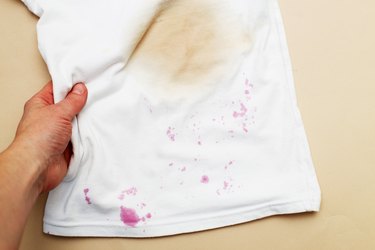
Removing Tipp-Ex or any other brand of correction fluid after an accidental spill or stain isn't easy, but it is usually possible. Your chances of successfully removing correction fluid from clothing, carpet or furniture are much higher if you notice and tackle the stain immediately, so don't delay. The best tools and cleaning solutions for removing correction fluid stains depend on the type of material that's stained. Be very careful not to use a solvent or cleaner that's too harsh for the stained surface or you risk causing additional damage beyond the stain.
Work While the Correction Fluid Is Wet
Video of the Day
If possible, start tackling a correction fluid stain while it's still wet. Immediately grab a paper towel or old rag and wipe up as much of the correction fluid as you can from the stained surface. Be careful in the way that you wipe, making sure to pinch the liquid up and off the surface rather than spreading it around or rubbing it in.
Video of the Day
Scrape Off the Dried Correction Fluid
After wiping off as much wet correction fluid as you can, let the remaining stain fully dry. If you discover a correction fluid stain that's already dried, start with this step. Scratch and scrape the dried fluid off the fabric, carpet or hard surface using an appropriate tool for that surface. Use common sense to select a tool that won't damage the surface, which might be a fingernail, butter knife, the edge of an old credit card, a plastic spoon or a bench scraper. Tougher fabrics and surfaces might be able to withstand a stiff scrubbing brush.
Scrape and scrub the dried correction fluid so that it flakes off, frequently brushing or blowing away the powdery residue as you work. Keep going until you've removed as much of the correction fluid stain as possible without damaging the surface. If you're lucky, this technique might be enough to remove all or most of the stain.
Apply an Appropriate Stain Remover
A number of common household cleaners and solvents can effectively remove a correction fluid stain, but the best choice will depend on the type of material that is stained. Choose one of these stain removers and test it on an inconspicuous area first. Once you've determined the stain remover is safe to use, apply it to the stain with a soft white rag or cotton swabs. Check the reverse side of the stain and apply stain remover there too if needed. Let it soak for a minute or two and then rinse with plain water. For garments, launder as usual at the hottest recommended water temperature.
- Rubbing alcohol: An excellent stain remover for correction fluid that is safe for most surfaces.
- Acetone or color-free nail polish remover: Safe for use on natural fibers and wood but not for synthetic fabrics, acrylic or laminated surfaces. It can also damage paint and stains on wood.
- Laundry stain remover spray: Read the label for instructions and appropriate fabric types.
- Liquid dish soap, including heavy-duty detergent: Safe for most surfaces and effective on stains.
- Dry cleaning solvent: Follow the manufacturer's instructions and advice regarding appropriate fabric types.
- Citrus solvent: Follow the manufacturer's instructions and advice regarding appropriate fabric types.
Tackling Tougher Stains
If traces of correction fluid remain after the stain removal step, repeat the application before drying the stained item. A dryer can set the stain and make it impossible to remove. You might try an alternative stain removal product if the first choice is ineffective. For tough stains on clothing, take the items to a dry cleaner for a professional treatment; this should be the first choice for dry-clean-only clothes.
With difficult correction fluid stains on wood furniture or other items, you might need to resort to refinishing the wood. Getting off the stain might only be possible with products that take the finish off the wood, so decide whether or not that is a project you are willing to tackle.